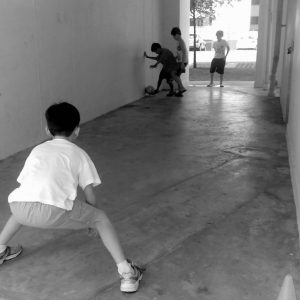Encountering enchantment: stories from the street football court in Singapore
August 30, 2021

The Singapore Amateur Football Association (SAFA) was founded on 29 August 1892. Now called the Football Association of Singapore (FAS), it is the governing body responsible for the sport’s development, organizing the professional league and cup competitions. Despite the popularity of football, street football is emerging as a popular alternative in Singapore. Street football courts are a common sight in and around public housing estates. They are also much smaller in size, which makes it convenient to have a casual game with a small number of friends.
In ‘Encountering enchantment: stories from the street football court in Singapore’ (Social & Cultural Geography, 2017), Assistant Professor Shaun Teo (NUS Geography) and Dr Harvey Neo (formerly NUS Geography) examine the concept of enchantment by ethnographically analysing encounters between Malay and Chinese users at two local street football courts in Singapore. In human geography, ‘enchantment’ is used to understand social encounters in public spaces. Current research (mainly Anglo-American) has thus far associated enchantment with positivity, symbolized by egalitarianism and serendipity.
The authors, however, suggest that enchantment encounters are more complex. They demonstrate how an enchantment encounter can be experienced and understood through the construction, perpetuation, and negotiation of boundaries. It is not an egalitarian encounter but one which is negotiated and experienced differently between the Malay and Chinese users of the street football court. Furthermore, the occasional but regular encounters between both ethnicities highlight how enchantment could also be understood by routinised everyday interactions rather than serendipity.
For the Malays, the court is further used as a communal space for non-football activities (doing schoolwork and having meals together). The bulk of time spent there meant they had established a sense of place for the court, even identifying the court as their second home. This placed the Malays in a position to construct and perpetuate the boundaries of encounter with others. In contrast, the Chinese users’ marginal but regular use of the court meant they were negotiating within these constructed boundaries. The authors hope that advancing theoretical research on the notion of enchantment will demonstrate the potential and possibility for meaningful interactions between different others in public spaces.
Read the article here.
